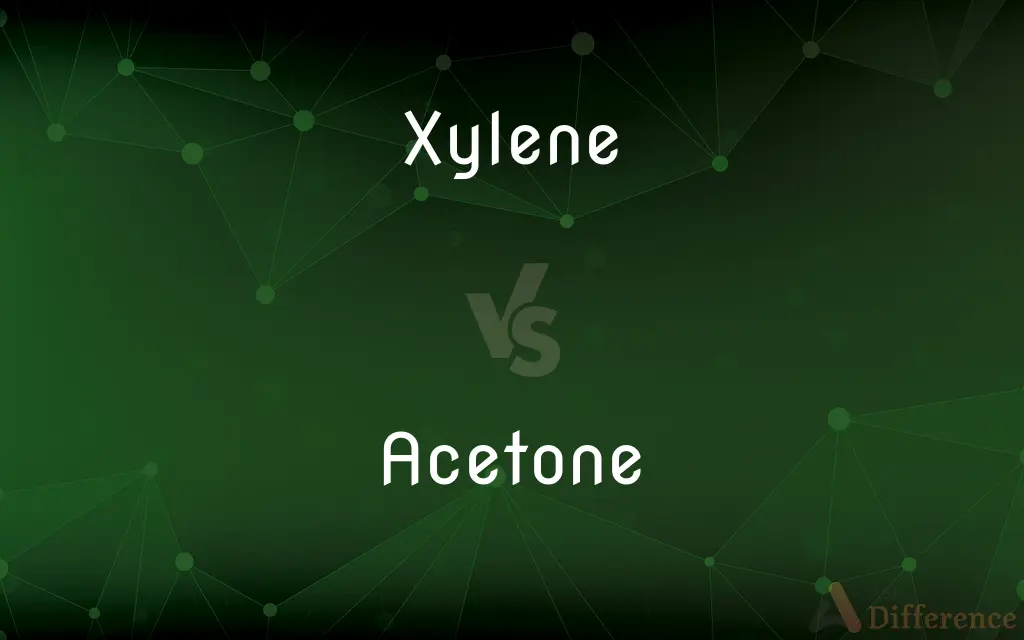Xylene vs. Acetone — What's the Difference?
By Maham Liaqat & Fiza Rafique — Updated on March 13, 2024
Xylene is a volatile, aromatic hydrocarbon used primarily as a solvent in the printing, rubber, and leather industries, while acetone is a fast-evaporating, flammable solvent widely used in nail polish remover and as a paint thinner.

Difference Between Xylene and Acetone
Table of Contents
ADVERTISEMENT
Key Differences
Xylene, a complex chemical derived from petroleum, is known for its ability to dissolve paints, varnishes, and other polymers, making it valuable in various industrial applications. Acetone, on the other hand, is a simpler compound with a broader range of uses, including in the cosmetic industry, laboratory settings, and in the production of plastics and synthetic fibers, thanks to its effectiveness in dissolving and cleaning.
While both xylene and acetone serve as solvents, xylene's slower evaporation rate makes it suitable for applications requiring a longer working time. Acetone evaporates much more quickly, which is advantageous in processes where rapid drying is desired, such as in nail polish removers or when cleaning surfaces.
Xylene's chemical structure allows it to act as a solvent for certain materials that acetone cannot dissolve as effectively, making it essential in specialized industrial processes. Acetone's more reactive nature, however, lends itself to a wider variety of chemical reactions, making it indispensable in organic chemistry labs.
The toxicity levels and safety precautions for handling these chemicals also differ. Xylene is considered more toxic, with exposure potentially affecting the nervous system, whereas acetone, while still requiring care, is less toxic and is a common ingredient in household products.
In terms of environmental impact, both chemicals pose risks, but acetone is considered to be less harmful due to its higher volatility and ability to break down more quickly in the environment. Xylene, with its slower degradation rate, presents more significant environmental concerns.
ADVERTISEMENT
Comparison Chart
Chemical Structure
Aromatic hydrocarbon
Simple ketone
Primary Use
Solvent in printing, rubber, and leather industries
Solvent in cosmetic industry, paint thinner, and chemical synthesis
Evaporation Rate
Slower
Faster
Solvency Power
High for specific materials
Broad range but less effective for some materials
Toxicity
More toxic, affecting the nervous system
Less toxic, safer for household use
Environmental Impact
Slower degradation, more environmental concerns
Higher volatility, breaks down more quickly
Compare with Definitions
Xylene
Requires specific safety measures due to its toxicity.
Handling xylene requires proper ventilation and protective gear.
Acetone
A fast-evaporating solvent used in nail polish remover.
Acetone effectively removes nail polish quickly.
Xylene
A volatile organic compound used as a solvent.
Xylene is often used to thin paints and varnishes.
Acetone
Commonly used in the synthesis of plastics.
Acetone is a key ingredient in making various synthetic materials.
Xylene
Known for its application in the printing industry.
The printing press uses xylene-based solvents for cleaning.
Acetone
Evaporates quickly, useful for rapid drying applications.
The rapid evaporation of acetone speeds up drying processes.
Xylene
Can affect the central nervous system if inhaled.
Prolonged exposure to xylene can lead to health issues.
Acetone
Less toxic and safer for household use.
Acetone can be used safely with adequate ventilation.
Xylene
Not suitable for use in all types of plastics.
Xylene can dissolve certain plastics, so it must be used cautiously.
Acetone
Versatile in laboratory settings for cleaning.
Acetone cleans laboratory glassware without leaving residue.
Xylene
Xylene (from Greek ξύλον xylon, "wood"), xylol or dimethylbenzene is any one of three isomers of dimethylbenzene, or a combination thereof. With the formula (CH3)2C6H4, in each of the three compounds a benzene ring is substituted by two methyl groups.
Acetone
Acetone, or propanone, is an organic compound with the formula (CH3)2CO. It is the simplest and smallest ketone. It is a colourless, highly volatile and flammable liquid with a characteristic pungent odour.
Xylene
Any of three colorless flammable isomeric benzene derivatives, C8H10, obtained from wood and coal tar.
Acetone
(organic compound) A colourless, volatile, flammable liquid ketone, (CH3)2CO, used as a solvent.
Xylene
A mixture of xylene isomers used as a solvent in making lacquers and rubber cement and as an aviation fuel.
Acetone
A volatile liquid consisting of three parts of carbon, six of hydrogen, and one of oxygen; pyroacetic spirit, - obtained by the distillation of certain acetates, or by the destructive distillation of citric acid, starch, sugar, or gum, with quicklime.
Xylene
(chemistry) Any of a group of three isomeric aromatic hydrocarbons, found in coal and wood tar.
Acetone
The simplest ketone; a highly inflammable liquid widely used as an organic solvent and as material for making plastics
Xylene
Any of a group of three metameric hydrocarbons of the aromatic series, found in coal and wood tar, and so named because found in crude wood spirit. They are colorless, oily, inflammable liquids, C6H4.(CH3)2, being dimethyl benzenes, and are called respectively orthoxylene, metaxylene, and paraxylene. Called also xylol.
Xylene
A colorless flammable volatile liquid hydrocarbon used as a solvent
Common Curiosities
Can xylene and acetone be used interchangeably?
Not always, as their solvency power and evaporation rates differ, making each suitable for specific applications.
Is acetone environmentally friendly?
While acetone is less harmful than xylene due to its ability to break down more quickly, it still requires careful handling and disposal to minimize environmental impact.
Why is acetone preferred as a nail polish remover?
Its fast evaporation rate and effectiveness in dissolving nail polish make it ideal for quick and efficient removal.
What safety precautions should be taken when using xylene?
Use in well-ventilated areas, wear protective gloves and eyewear, and avoid prolonged exposure.
How do the evaporation rates of xylene and acetone affect their uses?
Xylene's slower evaporation rate is suitable for applications needing a longer working time, while acetone's rapid drying is beneficial where quick evaporation is desired.
What makes acetone a common laboratory solvent?
Its versatility, rapid evaporation, and effectiveness in cleaning without residue make it a staple in labs.
What industries rely heavily on xylene?
The printing, rubber, leather, and paint industries rely heavily on xylene as a solvent.
What are the main uses of xylene?
Xylene is primarily used as a solvent in the printing, rubber, and leather industries, and for thinning paints and varnishes.
How are xylene and acetone produced?
Xylene is derived from petroleum through the process of distillation, while acetone can be produced both naturally in the body and synthetically through chemical processes.
Why is acetone considered less toxic than xylene?
Acetone is less toxic and more volatile, making it safer for household use and less likely to cause long-term health effects.
Can exposure to xylene have long-term health effects?
Yes, prolonged exposure can affect the nervous system and lead to other health issues.
Are there any materials that should not come into contact with acetone?
Yes, acetone can dissolve certain plastics and damage finishes, so it should be used cautiously on sensitive materials.
Can acetone be found in everyday products?
Yes, besides nail polish remover, acetone is found in household cleaners and some cosmetic products.
How do the chemical structures of xylene and acetone differ?
Xylene has a complex aromatic hydrocarbon structure, while acetone is a simpler compound with a ketone group, affecting their physical properties and applications.
What are the environmental considerations for using xylene?
Its slower degradation rate necessitates careful handling and disposal to prevent long-term environmental impact.
Share Your Discovery

Previous Comparison
Disaccharide vs. Polysaccharide
Next Comparison
Marrying vs. MarringAuthor Spotlight
Written by
Maham LiaqatCo-written by
Fiza RafiqueFiza Rafique is a skilled content writer at AskDifference.com, where she meticulously refines and enhances written pieces. Drawing from her vast editorial expertise, Fiza ensures clarity, accuracy, and precision in every article. Passionate about language, she continually seeks to elevate the quality of content for readers worldwide.














































